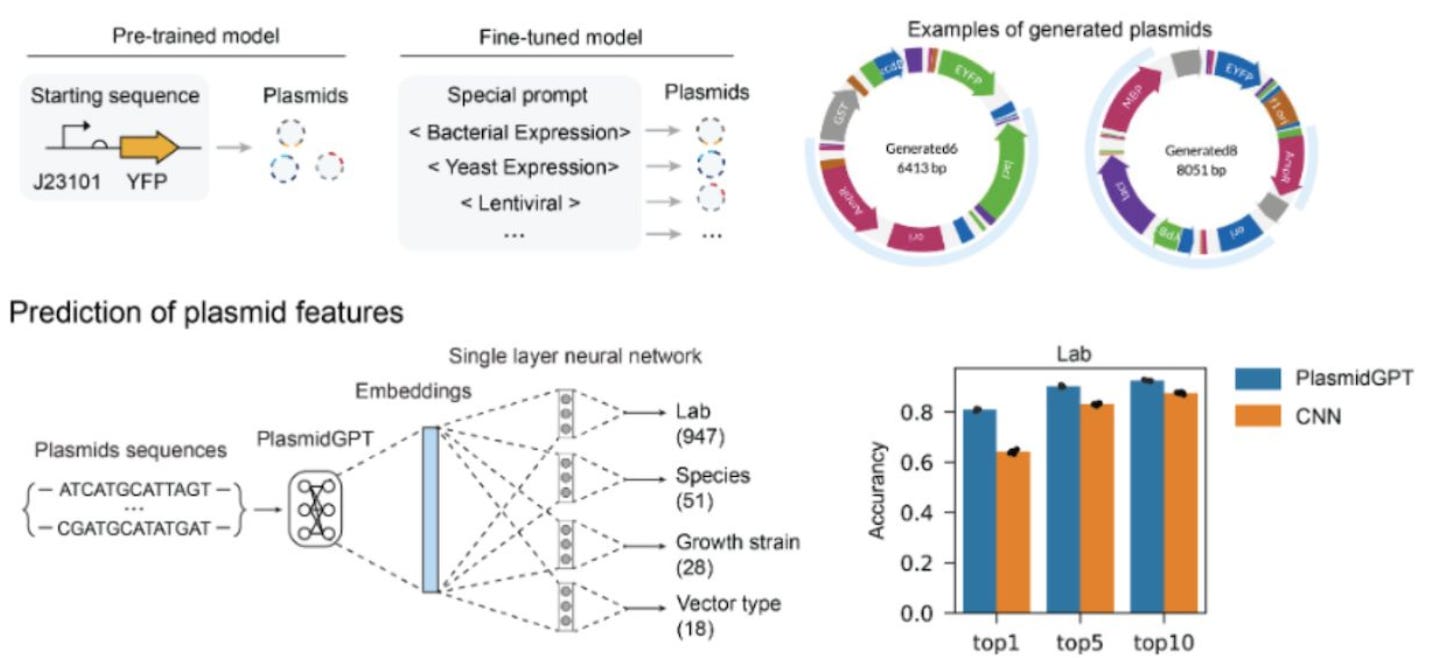In this issue:
Welcome back to your weekly dose of AI news for Life Science!
This week, we have some exciting new models lined up for you:
ProteinBench - Benchmark for Protein Foundation Models 🚀
PlasmidGPT - Foundation model for plasmid design 🧫
Orthrus - RNA Foundation Model 🧬
TxGNN - Drug Repurposing 💊
Dive into these game-changing innovations and explore how they are transforming the biotech and healthcare landscapes!
ProteinBench - Benchmark for Protein Foundation Models 🚀
The recent rise in protein foundation models has enhanced capabilities in protein prediction and generative tasks, though their strengths and weaknesses are not well understood due to a lack of a standardized evaluation framework. To address this, ProteinBench has been introduced as a comprehensive evaluation framework comprising a task taxonomy, multi-metric performance assessment, and detailed analysis to improve transparency and guide future research in the field.
📌 Key Insights:
Universal framework: Unified evaluation framework including
A taxonomy of protein-related tasks.
Assessment metrics focusing on quality, novelty, diversity, and robustness.
Analysis catering to diverse user objectives for a comprehensive evaluation.
Multiple benchmarks: The tool offers benchmarks for
Inverse folding
Structural design
Sequence design
Sequence and structure co-design
Motif scaffolding
Antibody design
Protein folding (single-state and multi-state prediction)
Distribution prediction
PlasmidGPT - Foundation model for plasmid design 🧫
Introducing PlasmidGPT, one of the first plasmid foundation model (110M parameters) to streamline the tedious process of plasmid design and analysis in synthetic biology!
📌 Key Insights:
Large training: PlasmidGPT has been trained on 923M base pairs of plasmid from Addgene engineered plasmid sequences for different species
Plasmid Annotation: PlasmidGPT can annotate the genetic elements into the plasmid sequence, such as the promoters, ribosome binding sites, coding sequence, and replication origin.
Prediction of Plasmid Attributes: The model can predict up to 51 attributes of the plasmid sequences, identifying elements such as promoters, ribosome binding sites, coding regions, and replication origins.
Orthrus - RNA Foundation Model 🧬
Orthrus is the latest RNA foundation model, pre-trained using a novel self-supervised learning method with biologically inspired augmentations!
📌 Key Insights:
Biologically-Informed Contrastive Learning: A novel learning method designed specifically for genomics, maximise similarity between splicing isoforms and orthologous transcripts across species.
Extensive Pre-training: Trained on splicing annotations from 10 species and orthologous alignments from 400+ mammalian species (Zoonomia Project), with a focus on sequences of high functional importance.
Superior Representations: Orthrus outperforms existing genomic models on 5 mRNA property prediction tasks, often surpassing supervised methods with just a simple linear transformation.
TxGNN - Drug Repurposing 💊
By leveraging extensive medical knowledge graphs, TxGNN employs a novel zero-shot prediction method that identifies potential drug candidates across a broad spectrum of diseases, facilitating faster and cost-effective therapeutic advancements.
📌 Key Insights:
The model leverages a medical knowledge graph containing extensive data on disease mechanisms and drug actions, comprising over 17,000 diseases and 7,900 drugs.
Unlike traditional models, TxGNN uses a zero-shot learning approach, allowing it to predict therapeutic candidates for diseases with minimal known data.
TxGNN outperforms existing drug-repurposing models, achieving significant improvements in predicting drug indications for diseases without approved treatments.
And the best part … the tool is open source!
Did you find this newsletter insightful? Share it with a colleague!
Subscribe Now to stay at the forefront of AI in Life Science.
Connect With Us
Have questions or suggestions? We'd love to hear from you!
📧 Email Us | 📲 Follow on LinkedIn | 🌐 Visit Our Website






